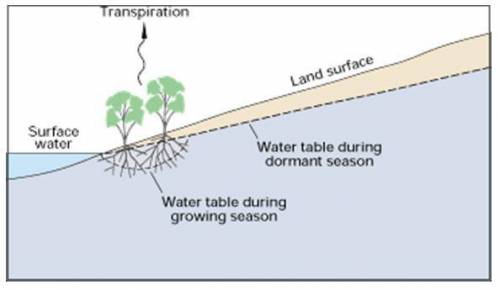
English, 29.01.2022 20:20 ant5784tgi
What is Evapotranspiration?
1 Evapotranspiration is defined as the water lost to the atmosphere from the ground surface and the transpiration of groundwater by plants through their leaves.
2 Transpiration is the process by which moisture is carried through plants from roots to small pores on the underside of leaves. There it changes to vapor and is released to the atmosphere.
3 Transpiration is essentially evaporation of water from plant leaves. About 10 percent of the moisture found in the atmosphere is released by plants through transpiration. Plant transpiration is an invisible process. Since the water is evaporating from the leaf surfaces, you don't just go out and see the leaves "breathing." During a growing season, a leaf will transpire many times more water than its own weight. A large oak tree can transpire 40,000 gallons (151,000 liters) per year.
Transpiration: The release of water from plant leaves
4 Just as you release water vapor when you breathe, plants do, too. However, the term "transpire" is more appropriate than "breathe." Plants put down roots into the soil to draw water and nutrients up into the stems and leaves. Some of this water is returned to the air by transpiration. Transpiration rates vary widely depending on weather conditions. During dry periods, transpiration can contribute to the loss of moisture in the upper soil zone. This can have an effect on vegetation and food-crop fields.
How much water do plants transpire?
5 Plant transpiration is pretty much an invisible process. Since the water is evaporating from the leaf surfaces, you don't just go out and see the leaves "breathing." Just because you can't see the water doesn't mean it is not being put into the air, though. An acre of corn gives off about 3,000-4,000 gallons of water each day. A large oak tree can transpire 40,000 gallons per year.
6 The amount of water that plants transpire varies greatly geographically and over time. There are a number of factors that determine transpiration rates:
Temperature: Transpiration rates go up as the temperature goes up, especially during the growing season, when the air is warmer.
Relative humidity: As the relative humidity of the air surrounding the plant rises the transpiration rate falls. It is easier for water to evaporate into dryer air than into more saturated air.
Wind and air movement: Increased movement of the air around a plant will result in a higher transpiration rate.
Soil-moisture availability: When moisture is lacking, plants can begin to age prematurely and transpire less water.
Type of plant: Plants transpire water at different rates. Some plants that grow in arid regions, such as cacti and succulents, conserve precious water by transpiring less water than other plants.
Transpiration and Groundwater
7 In many places, the top layer of the soil where plant roots are located is above the water table. Therefore, it is often wet to some extent. However, it is not totally saturated, as is soil below the water table. The soil above the water table gets wet when it rains as water seeps into it from the surface. But, it will dry out without additional precipitation. Since the water table is usually below the plant roots, the plants are dependent on water supplied by precipitation. In places where the water table is near the land surface, such as next to lakes and oceans, plant roots can penetrate into the saturated zone below the water table. This allows the plants to transpire water directly from the groundwater system. Here, transpiration of groundwater commonly results in a drawdown of the water table much like the effect of a pumped well.
Look at the second diagram attached to the passage. Which two sentences are true based on the diagram?
The slant of the land surface affects the surface water level.
The type of plants growing in the soil affects the process of transpiration.
Transpiration of groundwater by plants lowers the level of the water table.
The higher the level of surface water, the higher the level of the water table.
Plants growing near water bodies have roots that reach below the water table.


Answers: 3


Another question on English

English, 21.06.2019 20:30
How does the poem’s mood and tone change in each of these stages? odes and elgies
Answers: 2

English, 22.06.2019 00:00
Who is music included between news updated of the radio version of the war of the worlds
Answers: 3


English, 22.06.2019 07:10
Short stories by male dark romantic writers explored insanity, also called madness, as suffered by young women. what is the tone of this passage?
Answers: 1
You know the right answer?
What is Evapotranspiration?
1 Evapotranspiration is defined as the water lost to the atmosphere fr...
Questions




Computers and Technology, 25.11.2021 14:00








Mathematics, 25.11.2021 14:00

English, 25.11.2021 14:00


Social Studies, 25.11.2021 14:00


Mathematics, 25.11.2021 14:00





